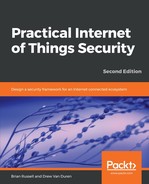Unauthorized disclosure of a secret or private cryptographic key or algorithm state effectively renders the application of cryptography useless. Encrypted sessions can be captured, stored, then decrypted days, months, or years later if the cryptographic key used to protect the session is acquired by a malicious entity.
Securely eradicating cryptographic keys from memory is the topic of zeroization. Many cryptographic libraries offer both conditional and explicit zeroization routines designed to securely wipe keys from runtime memory as well as long-term static storage. If your IoT device(s) implement cryptography, they should have well-vetted key zeroization strategies. Depending on the memory location, different types of zeroization need to be employed. Secure wiping, in general, does not just dereference the cryptographic key (that is, setting a pointer or reference variable to null) in memory; zeroization must actively overwrite the memory location either with zeroes (hence the term zeroization) or randomly generated data. Multiple overwrites may be necessary to sufficiently render the crypto variables irretrievable from certain types of memory attacks (for example, freezing memory). If an IoT vendor is making use of cryptographic libraries, it is imperative that proper use of its APIs is followed, including zeroization of all key material after use (many libraries do this automatically for session-based protocols, such as TLS).
For disposal of IoT devices containing highly sensitive PII data, you may also need to consider active destruction of memory devices. For example, hard drives containing classified data have been degaussed in strong electromagnetic fields for years to remove secret and top-secret data and prevent it from falling into the wrong hands. Mechanical destruction sufficient to ensure physical obliteration of memory logic gates may also be necessary, though degaussing and mechanical destruction are generally necessary only for devices containing the most sensitive data, or devices simply containing massive amounts of sensitive data (for example, hard drives and SSD memory containing thousands or millions of health records or financial data).
Zeroization is a topic some readers may know more about than they think. The recent (2016) conflict between the US Federal Bureau of Investigation and Apple brought to light the FBI's limitation in accessing a terrorist's iPhone without its contents (securely encrypted) being made irretrievable. Too many failed password attempts would trigger the zeroization mechanism, rendering the data irretrievable.
